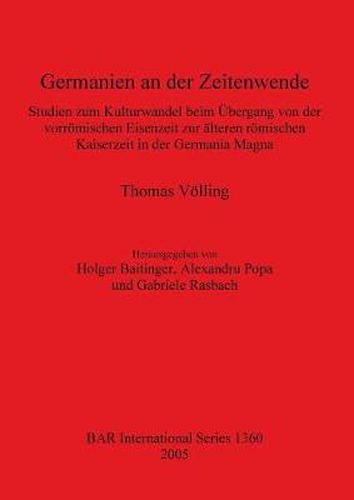Readings Newsletter
Become a Readings Member to make your shopping experience even easier.
Sign in or sign up for free!
You’re not far away from qualifying for FREE standard shipping within Australia
You’ve qualified for FREE standard shipping within Australia
The cart is loading…






This title is printed to order. This book may have been self-published. If so, we cannot guarantee the quality of the content. In the main most books will have gone through the editing process however some may not. We therefore suggest that you be aware of this before ordering this book. If in doubt check either the author or publisher’s details as we are unable to accept any returns unless they are faulty. Please contact us if you have any questions.
In the late Iron Age, much of Germany had adopted Celtic models with the same types of find occurring across the entire region. When Roman troops arrived, over the border in Gaul and then through incursions and raids into Germania, this changed; individual leaders emerged with their own distinct tribal groups that had to negotiate amongst themselves to face the Roman threat. According to Volling, this heralded that ‘Germania was at the threshold to historical awareness and thus overcoming prehistoric thought’. This study focuses on the 1st centuries BC and AD, searching for signs of cultural change in the archaeological record, particularly brooch types, the introduction of Roman finds, religious items and settlement types. Thomas Volling also compares evidence from across Germania and makes use of written sources. German text, English summary.
$9.00 standard shipping within Australia
FREE standard shipping within Australia for orders over $100.00
Express & International shipping calculated at checkout
This title is printed to order. This book may have been self-published. If so, we cannot guarantee the quality of the content. In the main most books will have gone through the editing process however some may not. We therefore suggest that you be aware of this before ordering this book. If in doubt check either the author or publisher’s details as we are unable to accept any returns unless they are faulty. Please contact us if you have any questions.
In the late Iron Age, much of Germany had adopted Celtic models with the same types of find occurring across the entire region. When Roman troops arrived, over the border in Gaul and then through incursions and raids into Germania, this changed; individual leaders emerged with their own distinct tribal groups that had to negotiate amongst themselves to face the Roman threat. According to Volling, this heralded that ‘Germania was at the threshold to historical awareness and thus overcoming prehistoric thought’. This study focuses on the 1st centuries BC and AD, searching for signs of cultural change in the archaeological record, particularly brooch types, the introduction of Roman finds, religious items and settlement types. Thomas Volling also compares evidence from across Germania and makes use of written sources. German text, English summary.